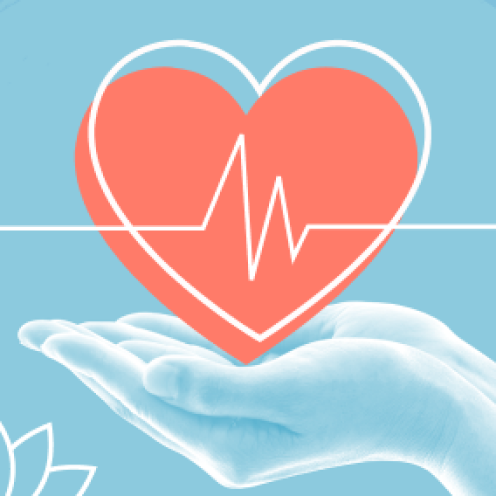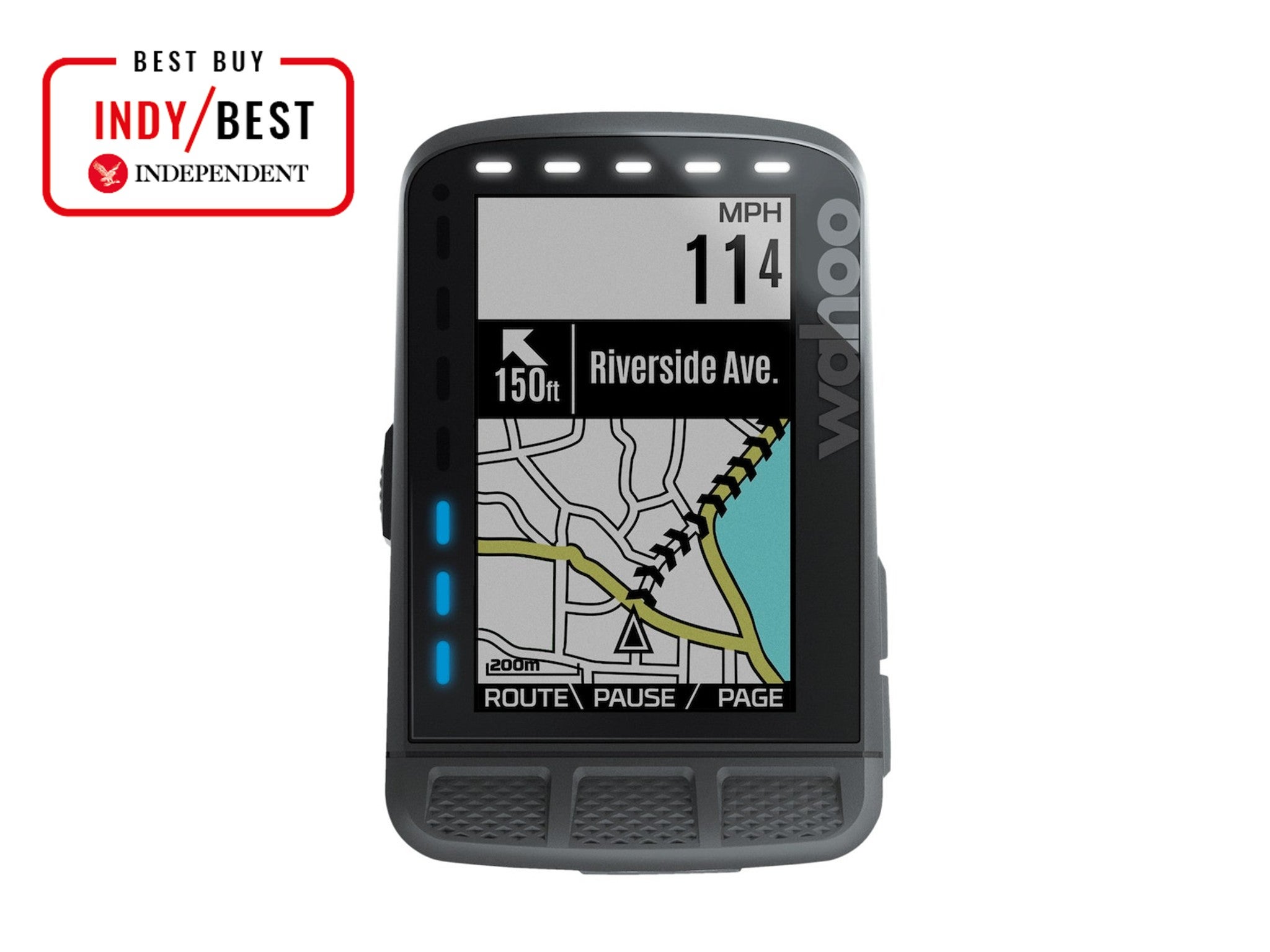
The Independent's journalism is supported by our readers. When you purchase through links on our site, we may earn commission. Why trust us?
8 best GPS cycling computers: Take your training up a gear
Guiding you from A to B, these clever devices make tracking your performance an easy ride
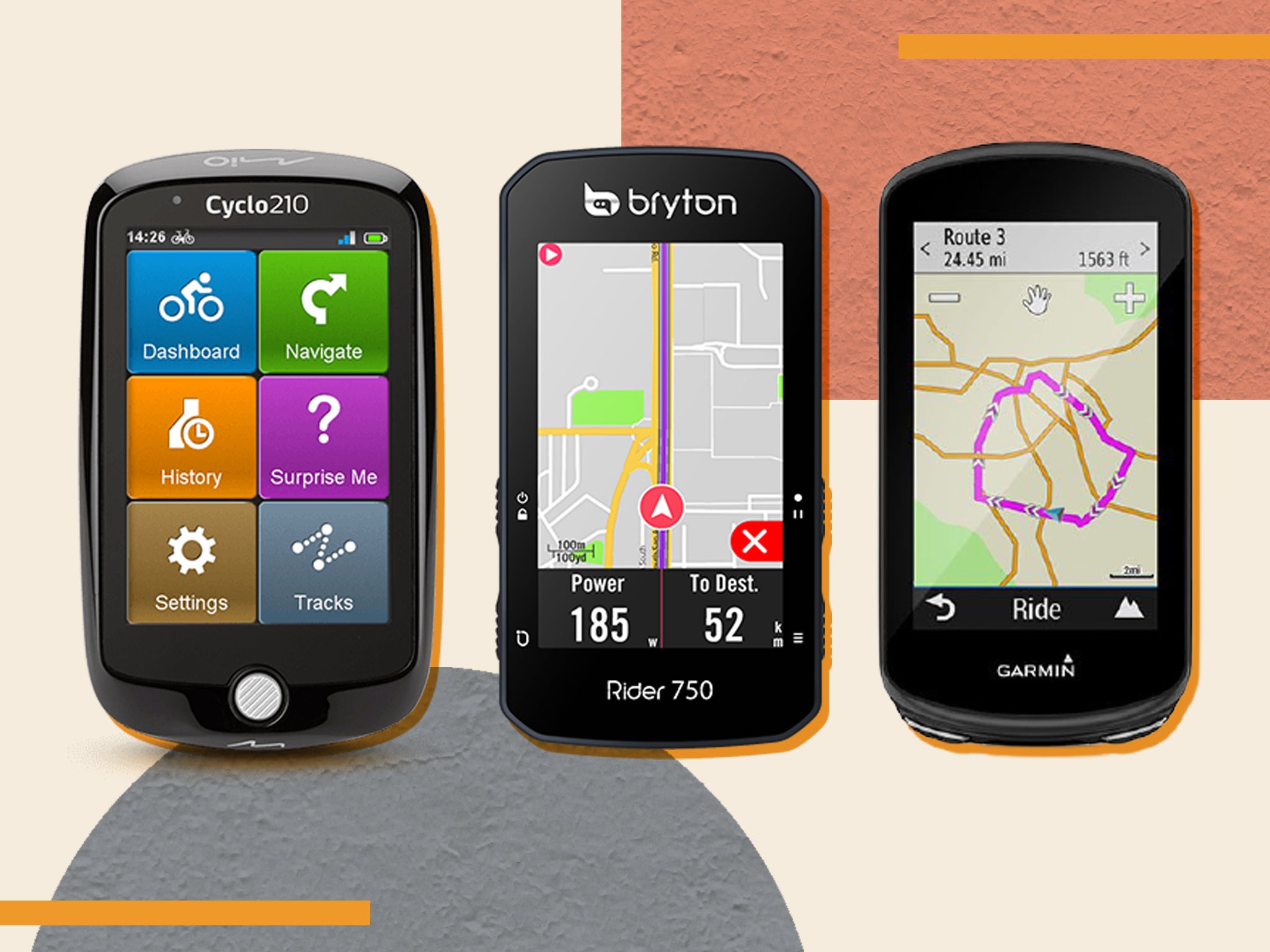
Whether you’re looking to track your training, map out new routes or smash some Strava segments, a good GPS cycling computer is a must-have.
Strava – a fitness app for tracking activities – has turned us cyclists into stats geeks. Whether we’re comparing times on a climb with mates or just recording how far we have ridden, we all love a bit of number crunching. GPS computers use satellites to pinpoint our position and then work out speed and distances ridden.
Most modern computers come enabled with ANT+, Bluetooth and wifi, meaning you can connect the likes of heart-rate monitors, power meters and cadence sensors, and upload your rides easily. Some devices also connect to your bike lights so you can control them and check their charge levels. Many will also connect to ebikes to let you know how much power the battery has left or which mode the motor is working in.
Plenty of these computers also integrate with Strava’s live segments feature, allowing you to see your timings up or downhill in real time.
Most GPS computers now include some form of navigation. Some allow you to follow “breadcrumb” trails – just a simple line on a basic map on screen that guides you in the right direction. Others have more detailed maps which let you plan routes on the go by selecting a street address or postcode. Many will also reroute you if you get lost, just like a GPS system in a car.
Read more:
How we tested
We tested our selection of computers on roads and tracks, in daylight and at nighttime, and even during indoor training sessions. We connected them to our cycling sensors and ran them in conjunction with a smart trainer to really put them through their paces.
The best GPS cycling computers for 2021 are:
- Best overall – Wahoo elemnt roam: £299.99, Sigmasports.com
- Best for tech lovers – Hammerhead karoo 2: £359, Hammerhead.io
- Best small computer – Wahoo elemnt bolt: £264.99, Wahoofitness.com
- Best for multi-day adventures – Garmin edge 1030 plus: £469.99, Garmin.com
- Best for beginners – Garmin 130 plus: £129.99, Garmin.com
- Best for urban exploring – Beeline velo: £99, Beeline.co
- Best for simplicity – Mio cyclo 210: £159.99, Halfords.com
- Best value bundle – Bryton rider 750 T: £279.99, Brytonsport.co.uk
Wahoo elemnt roam

Best: Overall
Rating: 9/10
- Dimensions: 89mm x 54.4mm x 17.8mm
- Touchscreen: No
- Colour display: Yes
- Screen size: 2.7in
- Weight: 95g
- Battery life: 17 hours
We’ve been using this computer for more than two years and it’s still our favourite. It’s got clear mapping, a nice big 2.7in screen and superb connectivity via ANT+ and Bluetooth. The pre-loaded global maps use a splash of colour to highlight features such as major roads and rivers – a feature we find much less distracting than some full-colour alternatives.
Wahoo has made it super-easy to customise the metrics you view – clicking direction arrows on the side allows you to see more or less information and lets you zoom in and out of the map. You can set the LEDs on the left of the screen to show heart rate or power zones, but beware – your ride companions might spot you are suffering if your lights turn red!
Wireless uploading to Strava is super quick – usually completed before we have walked back in from the garage at the end of a ride. A recent update has made it possible to view notifications from WhatsApp and Telegram (and others) while riding, as well as the usual call and text notifications. Routes are easy to load from the mobile app and the large display and audio cues makes them really easy to follow. Battery life is up to around 17 hours, and along with a standard mount you also get an out-front version in the box to keep your handlebars free from clutter.
Hammerhead karoo 2
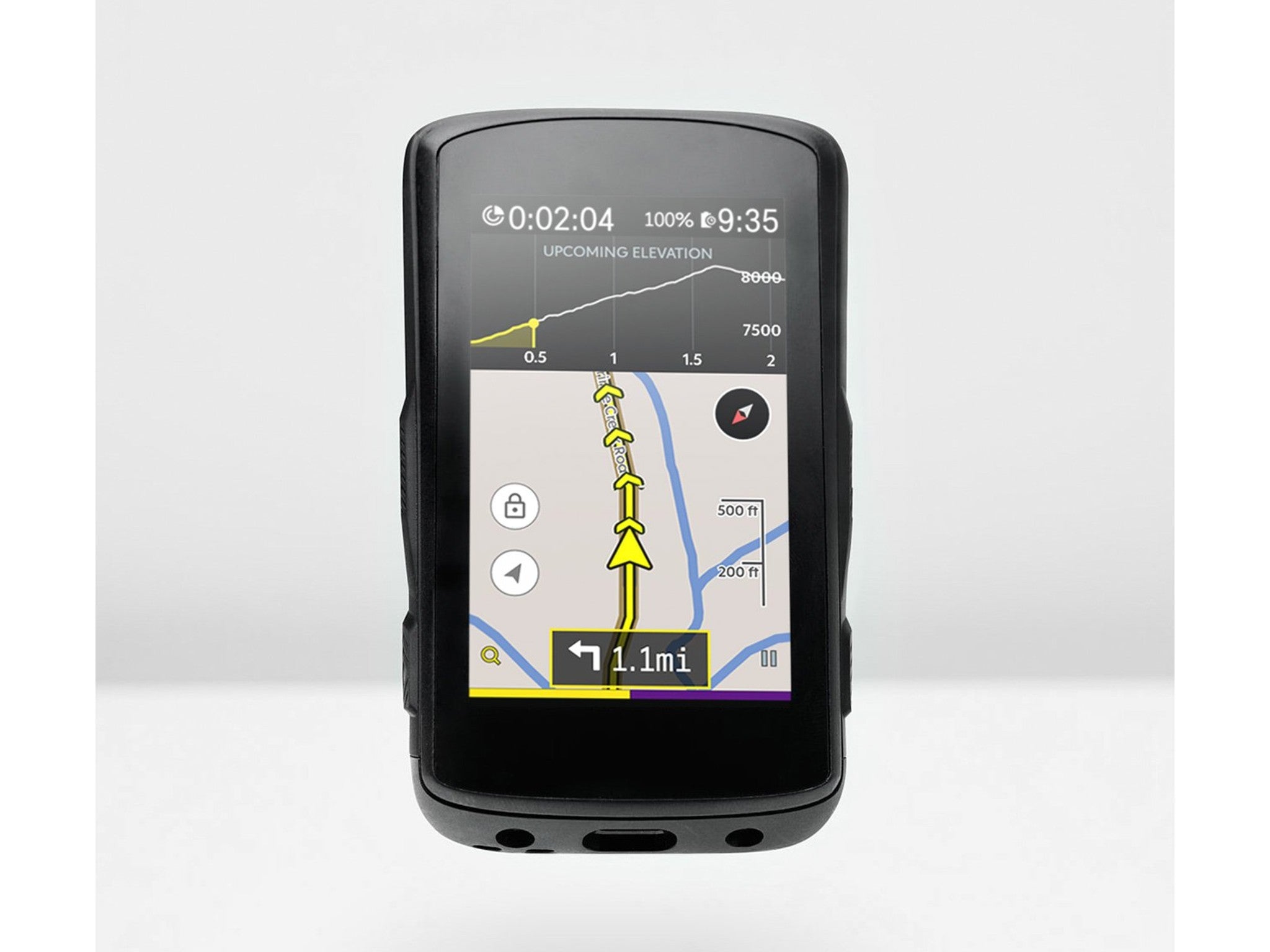
Best: For tech lovers
Rating: 9/10
- Dimensions: 60.8mm x 100.6mm x 19.3mm
- Touchscreen: Yes
- Colour display: Yes
- Screen size: 3.2in
- Weight: 167g
- Battery life: 12 hours
Good news for all you data geeks – there’s no shortage of ways to organise the metrics you see while you’re riding with this one, and it’s easy to personalise it to really suit your needs.
The 3.2in touchscreen is beautifully clear, even on bright days, and it’s easy to control with your finger, even in the rain. You can create routes on the device or download them from the internet with Hammerhead’s browser plug-in for Google Chrome. Following a route is simple thanks to the clear maps and audio cues, which let you know when you need to make a turn. And don’t fret if you’re wearing gloves, you can also control the computer with the two buttons on each side. If you like letting your loved ones track your location while you ride, there’s a SIM-card slot to add mobile data for live tracking.
In the box you get the unique Hammerhead out-front mount, plus an adapter to use a Garmin-style mount. Mounting is a bit fiddly the first time you try it, but it fits solidly in the mount and stays in place even on cobbled roads.
Charging is fast via USB-C (there’s a cable provided) and the roughly 12 hours’ battery life is more than enough for most of us. Make sure you don’t lose the detachable USB-C port cover, however, which is easy to misplace. Hammerhead frequently updates its software to provide a better experience, so we think this computer will stand the test of time. You can even change the colour of the device’s anti-shock bumper to match your bike – although it will cost you around £40 to do so.
Wahoo elemnt bolt
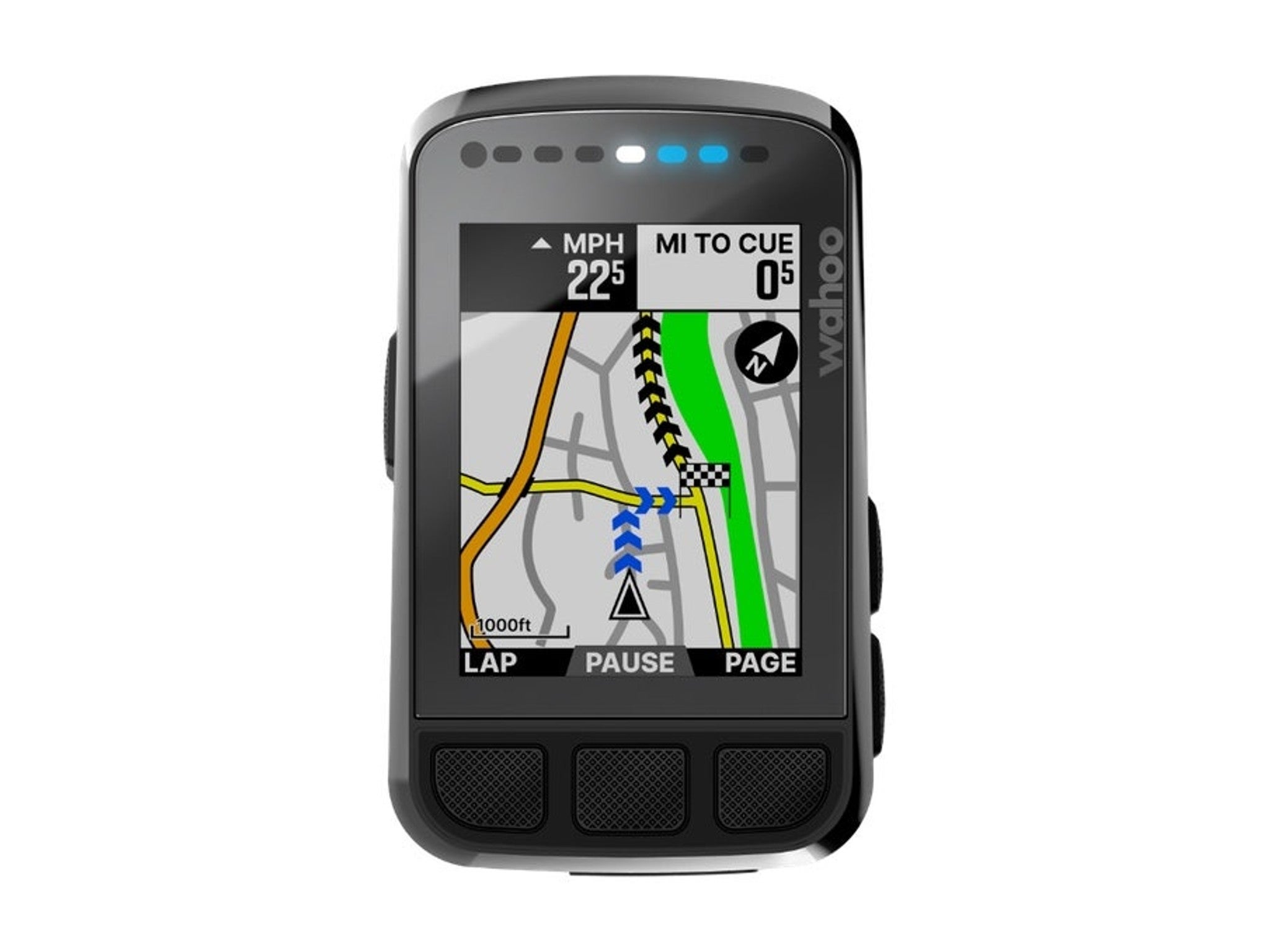
Best: Small computer
Rating: 8/10
- Dimensions: 77.4mm x 47.3mm x 21.3mm
- Touchscreen: No
- Colour display: Yes
- Screen size: 2.2in
- Weight: 68.4g
- Battery life: 15 hours
Great things come in small packages. With a 2.2in colour screen, this is a sleeker alternative to some of the other larger-display devices on test that won’t take up as much room on your bars. The elemnt bolt comes packed with powerful navigation features and global maps. You can make routes on the mobile app, follow them on screen and reroute if you get lost. The arrows of a planned route are easy to follow on the clear Gorilla Glass display, and there are audio cues when you approach a turn to keep you on track. You can pan and zoom the map to check out where a road leads if you’re ever in doubt about your direction, or if think you might be heading up a dead end.
The bolt has similar LED indication lights to its bigger brother (the elemnt roam), so you can monitor your power or heart-rate zones when you’re training or riding indoors. The 15-hour battery life is brilliant for such a small device and is plenty for even long rides. The computer comes with an out-front mount, a stem mount and a USB-C cable.
Garmin edge 1030 plus

Best: For multi-day adventures
Rating: 8/10
- Dimensions: 58mm x 114mm x 19mm
- Touchscreen: Yes
- Colour display: Yes
- Screen size: 3.5in
- Weight: 124g
- Battery life: 24 hours
Garmin has gone after the bikepacking and gravel-riding crowd with this update of its whopping 1030, but it will appeal to road riders too. It’s got a massive 3.5in touchscreen that works with gloves and comes loaded with nicely detailed colour maps to guide you both on and off-road. The battery lasts up to 24 hours when running on basic settings, and that can be doubled if you buy an optional clip-on power pack.
As you would expect from such a premium product, it works with all the sensors you could ever imagine and will connect to your indoor trainer or even an ebike. It’s loaded with data-rich features, including ClimbPro to tell you what tortures are ahead on an ascent, and training status to show whether your efforts are paying off. One nice feature for explorers is off-course recalculation. If you fancy having a nosy around somewhere new you can pause your route and then restart it when you are ready to get back on track. Rather than hitting you with warnings that you have missed a turn, the Garmin will work out how to return to your planned route and get you back on track.
Garmin 130 plus
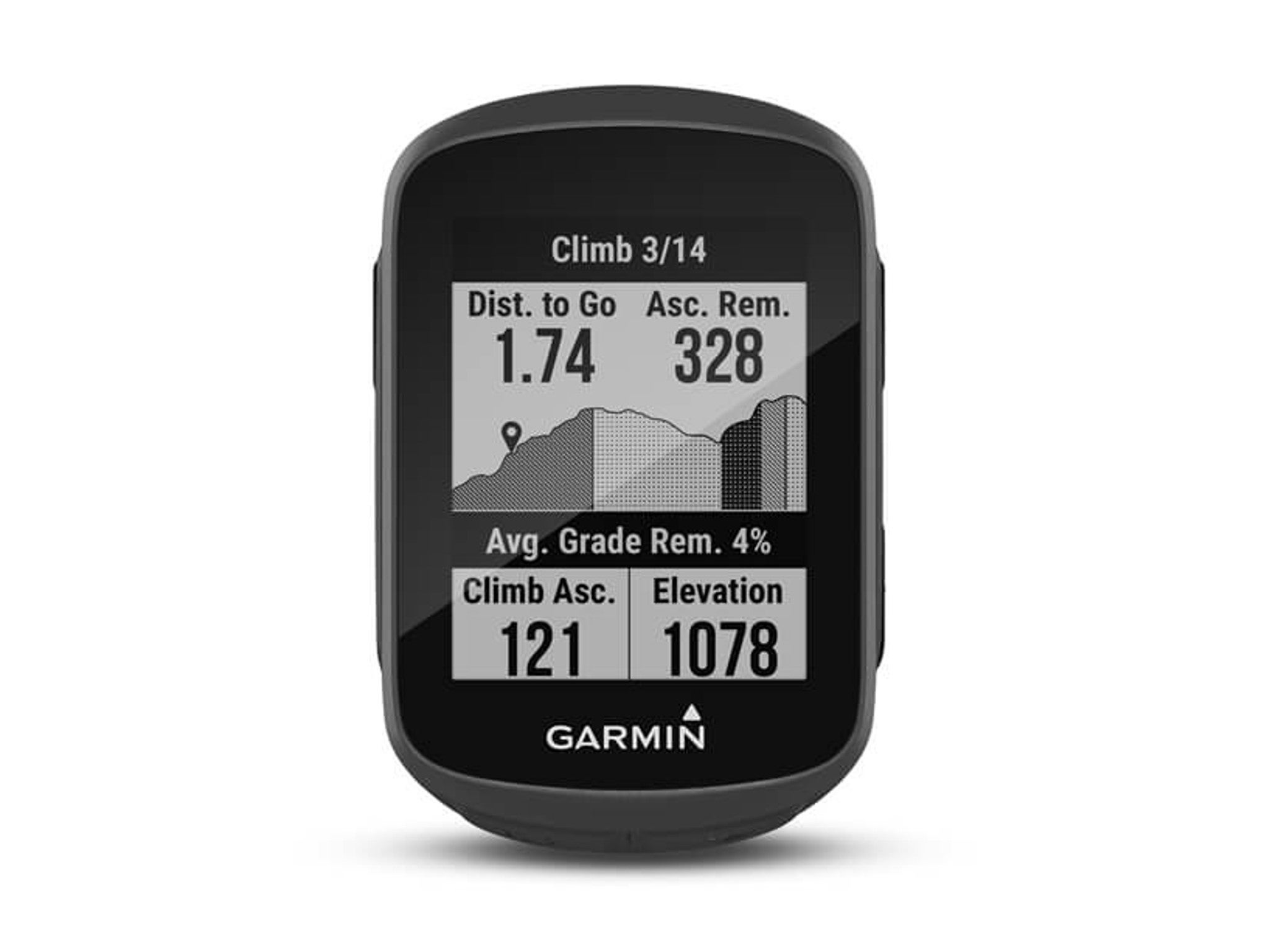
Best: For beginners
Rating: 7/10
- Dimensions: 41mm x 63mm x 16mm
- Touchscreen: No
- Colour display: No
- Screen size: 1.8in
- Weight: 33g
- Battery life: 12 hours
Not everyone wants a complicated computer with all the bells and whistles – if you’re after something simple, the 130 plus is great value. It’s small and simple, and the 1.8in screen won’t take up much space on your bars, yet it still has ANT+ and Bluetooth connectivity, and will let you view all your important data including speed, power and heart rate when paired with the appropriate sensors.
There’s also the ClimbPro found in more expensive Garmin units and breadcrumb navigation so you can follow routes. Battery life is up to 12 hours and works with Strava’s live segments. It’s got LiveTrack to let friends and family follow your progress, and it will show call and text notifications when linked to your phone. It can even give you the latest weather forecast on screen, and comes with three spare stem mounts, plus a charging cable.
Beeline velo
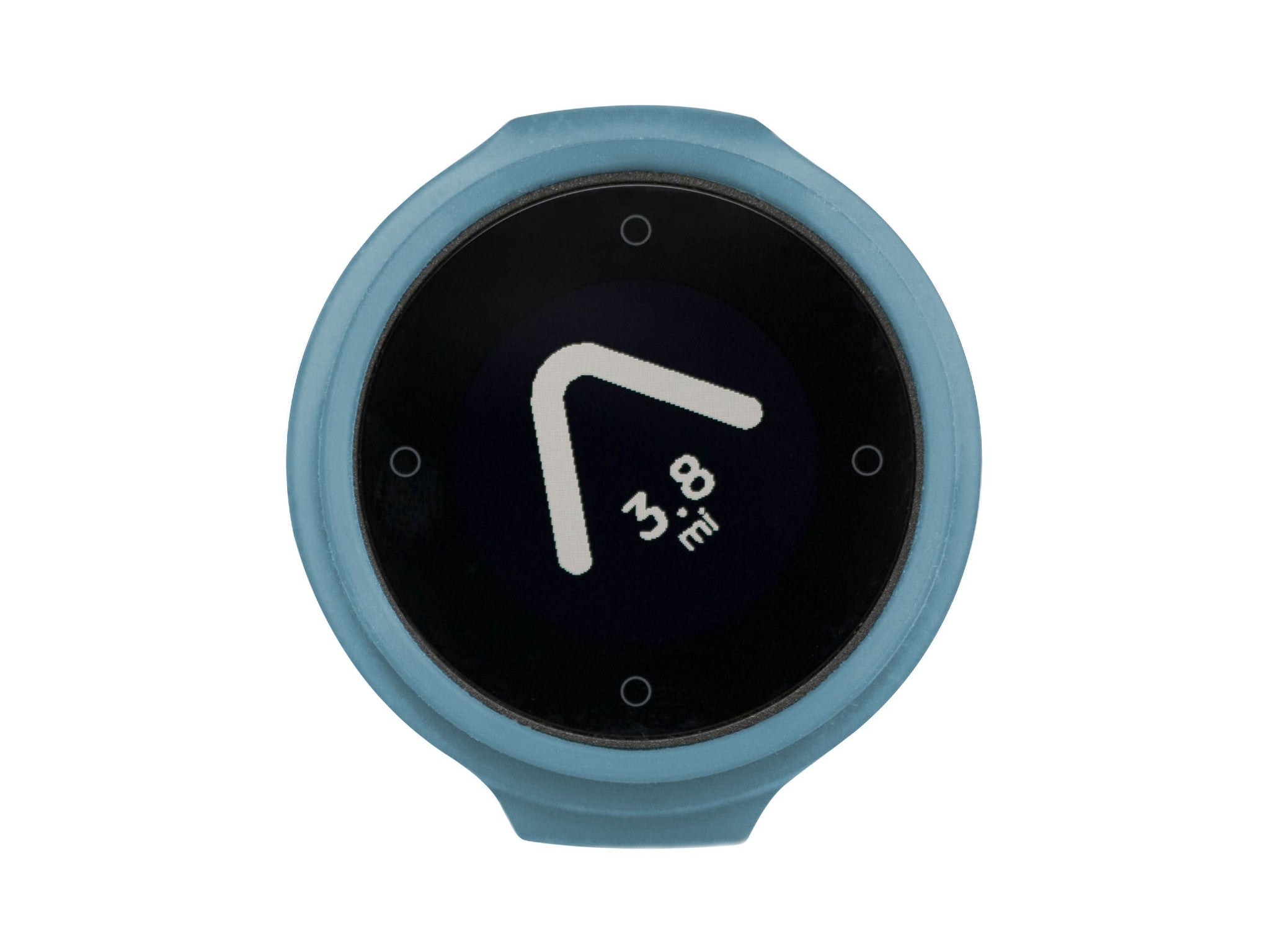
Best: For urban exploring
Rating: 7/10
- Dimensions: 65mm diameter, 18mm depth
- Touchscreen: No
- Colour display: Yes
- Screen size: 65mm
- Weight: 33g
- Battery life: 30 hours
The Beeline works like an old-style compass updated for the 21st century. If you’re looking for a fun way to find your way around, this could be perfect. You enter your destination into a companion phone app and it will then plot out a route for you, or you can freestyle it and just follow the arrow on the screen.
You just get basic information, such as speed, the distance to your next turn, time and distance. If you don’t care about having pages of data at your fingertips and enjoy seeking out new tracks and lanes, you’ll love it. It’s available in four colours, is lightweight and mounts via a rubber strap in seconds, so it’s perfect for bringing away on a city break where you might hire a bike. While it’s mainly a navigation tool, you can also record your rides and upload them to Strava.
Mio cyclo 210
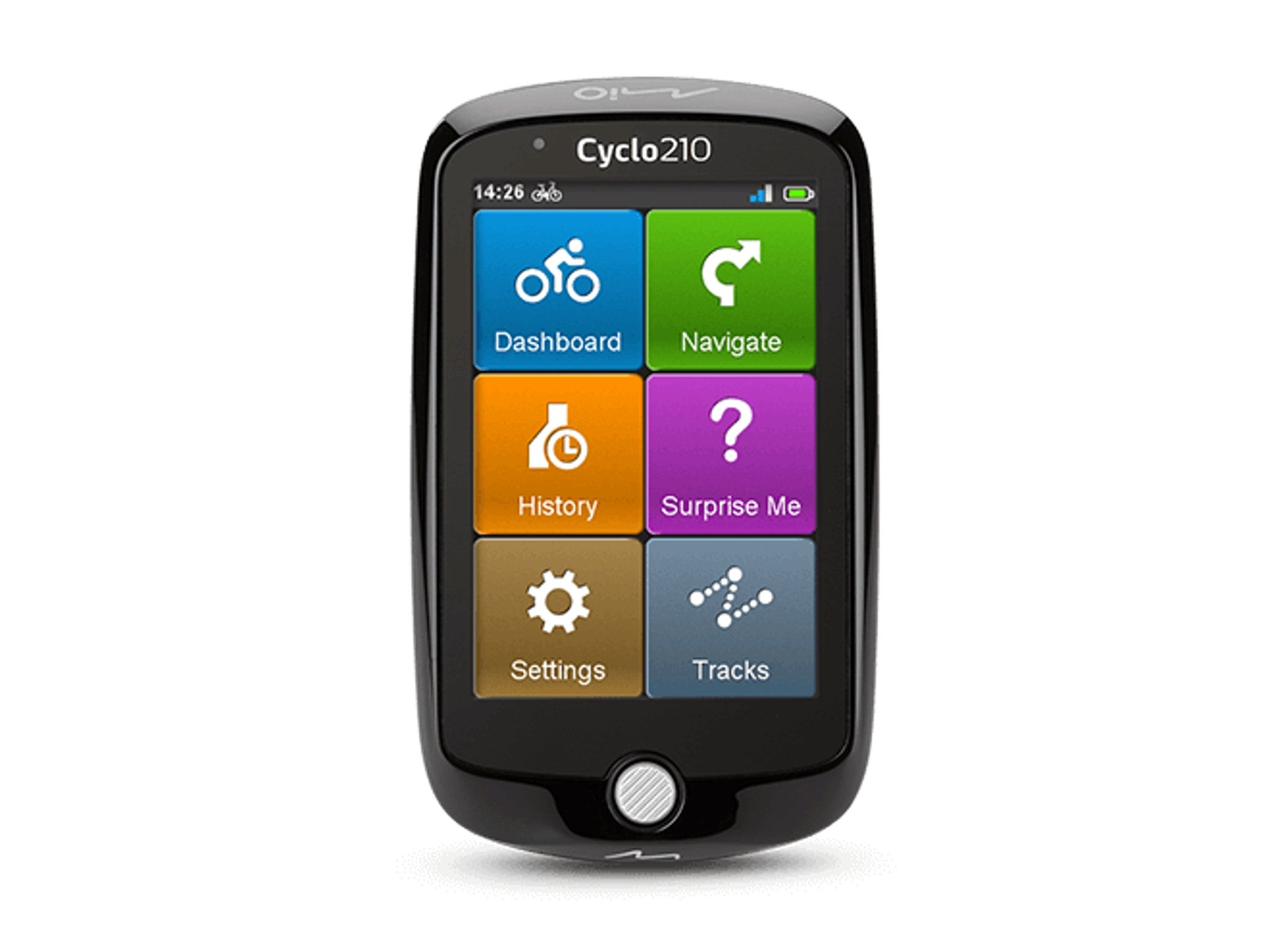
Best: For simplicity
Rating: 7/10
- Dimensions: 68mm x 114mm x 18.6mm
- Touchscreen: Yes
- Colour display: Yes
- Screen size: 3.5in
- Weight: 151g
- Battery life: 10 hours
A 3.5in colour touchscreen makes this one great for navigation. You can use it like a car GPS unit, right down to typing in a postcode and then selecting a street and house number. It will find the route in seconds and you also get a little elevation profile to let you know what terrain you will face.
The 210 uses the excellent OpenStreetMap system and you can choose between city bike, mountain bike, race bike and run/walk profiles so it can select the most suitable route to follow. We put the navigation to the test by taking a few wrong turns on our test rides, but it always managed to get us back on course.
It’s got a touchscreen, so there’s just one button on the unit. Things have been kept simple, so it lacks ANT+ or Bluetooth connectivity – meaning you can’t link up sensors and must use a cable to download rides to your laptop. It weighs in at around 150g and battery life is up to 10 hours.
Bryton rider 750 T
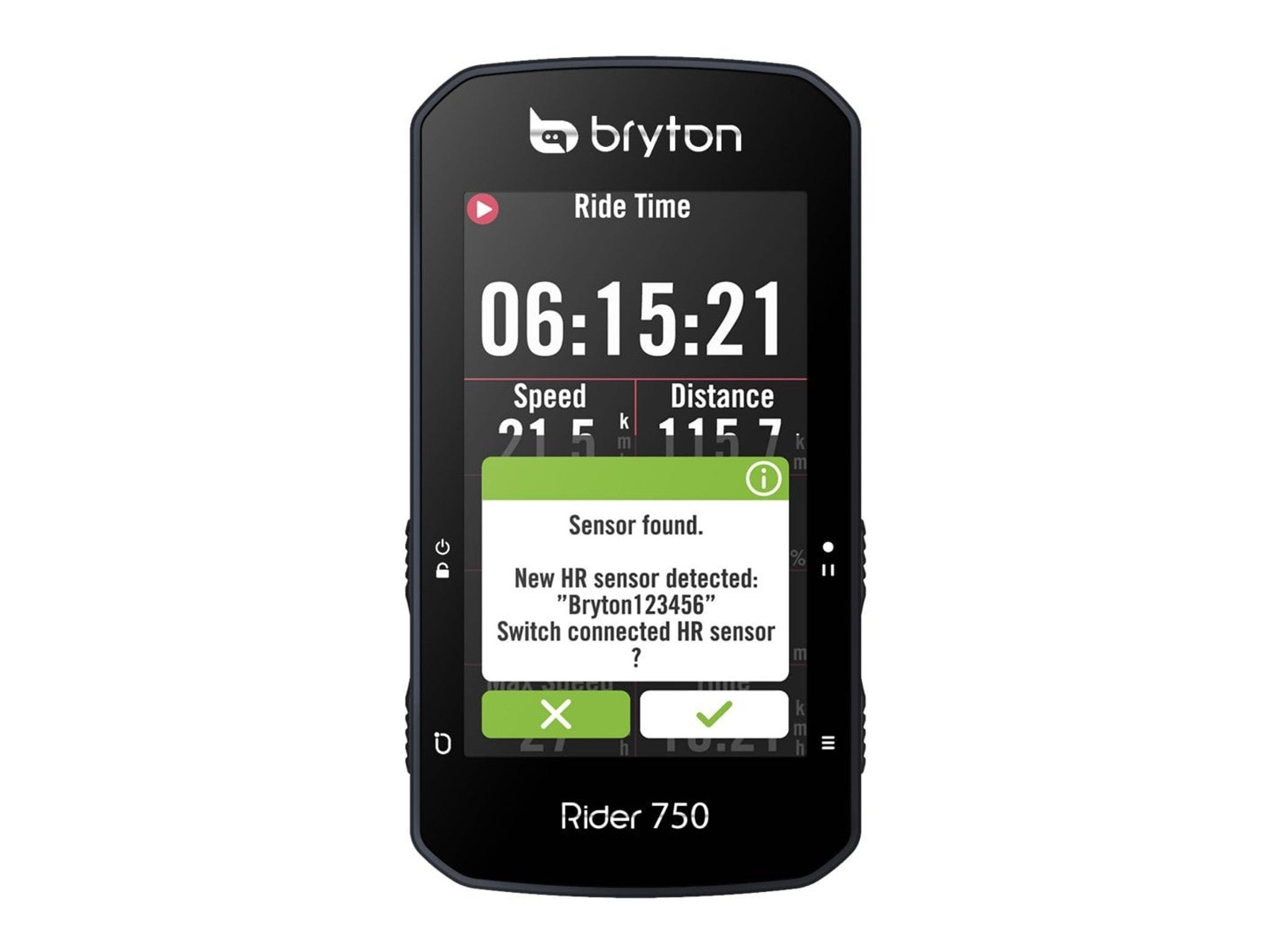
Best: Value bundle
Rating: 8/10
- Dimensions: 92.5mm x 49.7mm x 23.8mm
- Touchscreen: Yes
- Colour display: Yes
- Screen size: 2.8in
- Weight: 93g
- Battery life: 20 hours
This one’s a real bargain – you get a colour touch screen, sturdy metal out-front mount, cadence, speed and heart-rate sensors in the box. But the 750’s real unique selling point is its voice navigation. We were a bit sceptical but it works surprisingly well, even with background noise such as traffic. We initially had a bit of trouble updating the firmware and loading the maps for our region from the Bryton website, but once done the navigation worked really well – even when we tried a bit of unscheduled rerouting to catch it out. On the downside, if wearing gloves you’ll have to remove them to interact with the touchscreen, and the unit is a little slow to react compared with more expensive rivals. There are profile pages available for three different bikes – handy if you want different data on screen according to whether you are commuting or training – and the battery claims to last for 20 hours. Good news for home trainers and e-bike users though, the Bryton will work with these too.
GPS bike computer FAQs
Can a phone replace a bike computer?
If you don’t want to spend money on an expensive GPS computer, your smartphone can be used to record your rides and navigate routes. Buying a phone mount allows you to fit it to the bars while riding and use your phone like a bike computer.
While this works, we would recommend investing in a dedicated device instead. Bike computers are usually smaller than your phone, so will take up less space on the bars, while they’re also designed to be waterproof, generally more lightweight, and are much less likely to fall off while you’re riding, which could end up being costly. It’s also great to not drain the battery life of your phone on the ride, as you may want to use it to take photos at your destination.
What to look for in a cycling computer
Firstly, look for a GPS with connectivity via ANT+ or Bluetooth that will allow you to connect your cycling sensors. A wifi-enabled model, meanwhile, will let you upload rides to the internet with ease. If you are planning a cycling adventure, the ability to follow routes is a must. If you often get lost or want to change your route on the go, it’s a good idea to look for a device with built-in maps. We also recommend looking for a lengthy battery life of at least 10 hours, so you don’t get caught out on very long rides, or if you forget to charge.
The verdict: GPS bike computers
After more than two years of testing bike computers, we still think the Wahoo elemnt roam is our best buy. With a quality colour screen that’s perfect for navigating and easy connectivity to your sensors and phone, you can’t go wrong.
If you don’t want the complicated features of some of the flagship models, we recommend the Garmin edge 130 plus. Its tiny size means it takes up hardly any room on the bars and it’s got plenty of features for the average rider.
Hammerhead’s karoo 2 is also a great choice if you love to customise your device. It’s got a beautiful screen, has tons of features and options and it’s always receiving software upgrades to make the experience even better.
Voucher codes
For the latest discounts on smartwatches and other tech offers, try the below links:
Ensure you’re kitted out for winter rides with the best cycling gloves and best cycling socks
